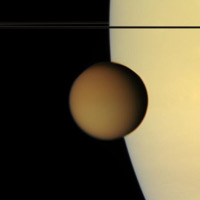Alien Vs. Editor: Life As We May (or May Not) Know It
Monday, April 18th, 2011
Alien vs. Editor is a forum for questions and answers about extrasolar planets and NASA’s search for life beyond our solar system. Leave your questions for author Steve Edberg and read more on the PlanetQuest website.

Tubeworms that grow near the boundary where hot vent fluid mixes with cold seawater on the ocean floor are an example of extremophiles that broaden our perspective on where to look for life. Image credit: Nicolle Rager Fuller, National Science Foundation
A reader’s question (paraphrased): Why do astronomers assume there have to be conditions similar to Earth in order for life to exist? Who are we to define what life looks like and how would we know what we’re looking at if we really don’t know what we are looking for?
This has been a recurring question over the years, and I don’t think anyone interested in finding extraterrestrial life would dispute those thoughts. The problem is that we aren’t as clever as Mother Nature, so we don’t know what else to look for. More practically, we don’t know what other conditions to look for beyond those we are familiar with.
Science fiction writers have used their imaginations to propose other forms of life. Sir Fred Hoyle (an astronomer) wrote a novel titled “The Black Cloud,” (SPOILER/GIVEAWAY ALERT!! SKIP THE REST OF THIS SENTENCE IF YOU THINK YOU WILL READ THE BOOK) about a self-propelling interstellar cloud that came to orbit the sun to acquire energy (it stopped for lunch!) before moving on.
On the TV shows “Star Trek” and “Star Trek: The Next Generation,” the screenwriters came up with at least two forms of life that were completely novel. Naturally enough, the shows involving them were about recognizing that they were life and how to deal with it. The one on “Star Trek” was about rock-beings that tunneled through an asteroid or planet. The other, on “Star Trek TNG,” was about “nanites,” microscopic silicon crystals that were hive-like beings communicating among themselves electrically and with electromagnetic waves with the crew of Enterprise D.
These are three examples of potential life forms far different from what we are familiar with. But knowing what to look for and where is a long step from the presentation of these ideas in science fiction media.
Before the Viking landings on Mars in the 1970s, Carl Sagan gave talks about the life-detecting instruments aboard the landers, which were designed to detect life as we know it. He also mentioned that there was a camera aboard so that we could see any “silicon-based giraffes that might walk by,” so even then scientists were thinking about possible, unfamiliar forms of life.
The strategy being followed is to look for evidence of extraterrestrial life, as we recognize life, now, rather than wait until we figure out all the possibilities. Scientists study and search for new examples of “extremophiles” that live in extreme conditions compared to what most of life on Earth lives in, in order to broaden our perspective on where to look for life.
There are also radio and optical searches for evidence of extraterrestrial intelligence living (by whatever chemical process) on planets orbiting other stars that might be announcing their presence. And I recently heard that there is a meeting planned to consider what else we might look for in this arena, considering that the era of our radio transmissions out to the galaxy (TV and radio) could be coming to an end as we use more cable and fiber communications here on Earth.

























